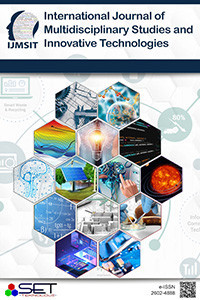Explication of the Remote Education Through Department Statistics: ESOGU-CENG Case Study
Explication of the Remote Education Through Department Statistics: ESOGU-CENG Case Study
Covid-19, effects of the pandemic, online education, remote education,
___
- L. Harasim, "Shift Happens: Online Education as a New Paradigm in Learning," The Internet and Higher Education, vol. 3, no. 1-2, pp. 41- 61, 2000.
- I. E. Allen and J. Seaman, Going the Distance: Online Education in The United States, 2011. ERIC, 2011.
- R. Heradio, L. De La Torre, D. Galan, F. J. Cabrerizo, E. HerreraViedma, and S. Dormido, "Virtual and Remote Labs in Education: A Bibliometric Analysis," Computers & Education, vol. 98, pp. 14-38, 2016.
- C. N. Pittman and A. K. Heiselt, "Increasing accessibility: Using Universal Design principles to address disability impairments in the online learning environment," Online Journal of Distance Learning Administration, vol. 17, no. 3, 2014.
- T. Volery and D. Lord, "Critical Success Factors in Online Education," International Journal of Educational Management, 2000.
- ReliefWeb. (2021, September 8, 2021). One Year into COVID-19 Education Disruption: Where Do We Stand? Available: https://reliefweb.int/report/world/one-year-covid-19-educationdisruption-where-do-we-stand
- B. University. (2021, September 16, 2021). Baylor’s COVID-19 Resources - Online Program Status. Available: https://onlinegrad.baylor.edu/covid-19/
- U.S. Department of Education. (2021, September 15, 2021). Education in a Pandemic: The Disparate Impacts of COVID-19 on America’s Students. Available: https://www2.ed.gov/about/offices/list/ocr/docs/20210608-impacts-ofcovid19.pdf
- A. V. Pesha and T. A. Kamarova, "Online Education: Challenges and Opportunities for Developing Key Competencies of the 21st Century During the COVID-19 Pandemic," in Research Technologies of Pandemic Coronavirus Impact (RTCOV 2020), 2020, pp. 155-160: Atlantis Press.
- T. Chen, L. Peng, B. Jing, C. Wu, J. Yang, and G. Cong, "The Impact of the COVID-19 Pandemic on User Experience with Online Education Platforms in China," Sustainability, vol. 12, no. 18, p. 7329, 2020.
- T. Muthuprasad, S. Aiswarya, K. S. Aditya, and G. K. Jha, "Students’ Perception and Preference for Online Education in India During COVID -19 Pandemic," Social Sciences & Humanities Open, vol. 3, no. 1, p. 100101, 2021.
- A. Arik, S. Okyay, and N. Adar, "Hybrid Course Recommendation System Design for a Real-Time Student Automation Application," European Journal of Science and Technology, no. 26, pp. 85-90, July 2021.
- ISSN: 2602-4888
- Yayın Aralığı: Yılda 2 Sayı
- Başlangıç: 2017
- Yayıncı: SET Teknoloji
Makine Öğrenimi ile Uzun Kuyruk Ürünler için İyileştirilmiş Sonraki Öğe Önerisi
Ahmet ZENCİRLİ, Harun ÇETİN, Nedim TUĞ, Engin SEVEN, Tolga ENSARİ
American Sign Language Recognition using YOLOv4 Method
Ali AL-SHAHEEN, Mesut ÇEVİK, Alzubair ALQARAGHULI
Nesnelerin İnterneti Cihazlarına Karşı Yapılan Makine Öğrenmesi Saldırıları
Mehmet İŞCAN, Ali Ihsan TAS, Berkem VURAL, Ali Burak OZDEN, Cüneyt YILMAZ
A Novel Student Performance Evaluation Model Based on Fuzzy Logic for Distance Learning
Beyza ESİN ÖZSEVEN, Naim CAGMAN
Author Identification with Machine Learning Algorithms
İbrahim YÜLÜCE, Feriştah DALKILIÇ
Weeds Detection using Deep Learning Methods and Dataset Balancing
Fadıl ARIKAN, Şebnem BORA, Aybars UGUR
Roblox Studio İle Mühendislik Eğitimi İçin Deneyim Geliştirme
Efficient Hardware Optimization for CNN
Seda GÜZEL AYDIN, Hasan Şakir BİLGE
Şebnem BORA, Aylin KANTARCI, Arife ERDOĞAN, Burak BEYNEK, Bita KHEİBARİ, Vedat EVREN, Mümin Alper ERDOĞAN, Fulya KAVAK, Fatmanur AFYONCU, Cansu ERYAZ, Hayriye GÖNÜLLÜ
